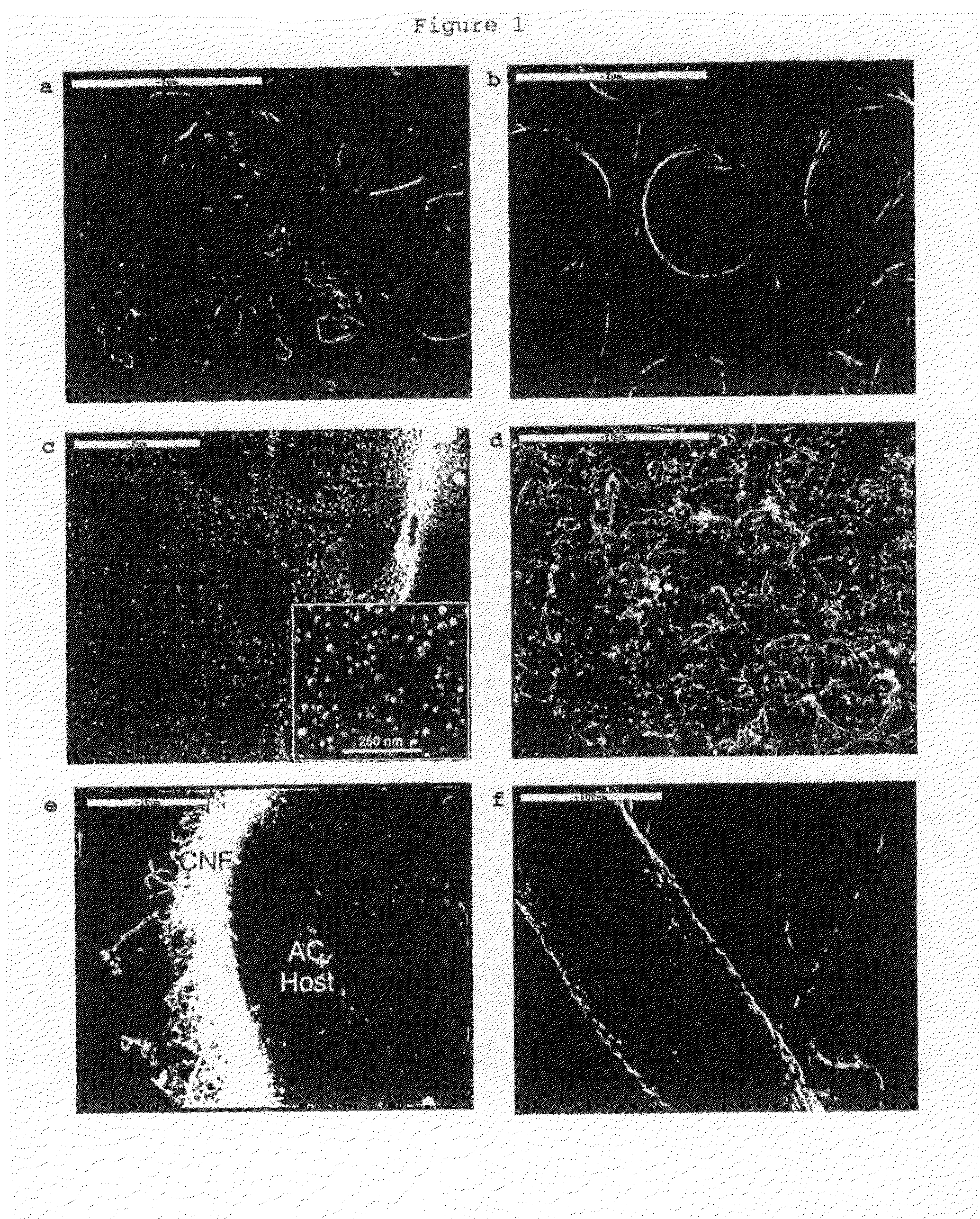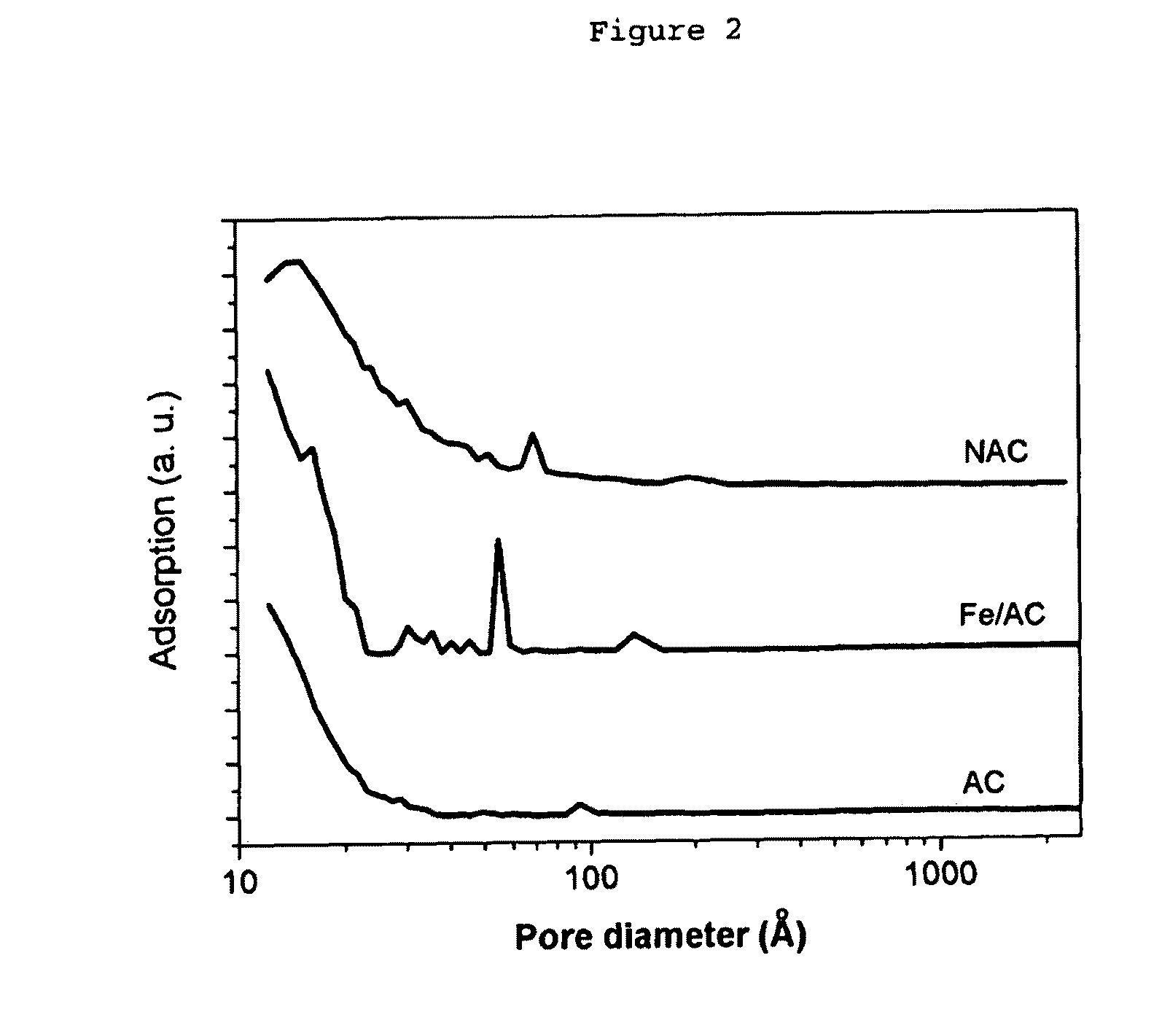Nanocarbon-activated carbon composite
a carbon composite and carbon-activated technology, applied in the field of nanocarbon-activated carbon composites, can solve the problems of destroying or at least inhibiting the access of the reactant medium, loose cnt/cnfs, and impede large-scale applications, and achieve the effect of lowering the percolation limi
- Summary
- Abstract
- Description
- Claims
- Application Information
AI Technical Summary
Benefits of technology
Problems solved by technology
Method used
Image
Examples
example 1
[0252]The activated carbon used as carrier was obtained from VERSATEC SDN (Malaysia). It was made from palm kernel shell, a waste product from palm production. It contains, besides carbon, substantial amounts (about 6 wt.-%) of silicate and traces of iron as iron silicate after the activation. The activation is done in a proprietary step by and comprises partial oxidation and steam treatments.
[0253]The activated carbon was crushed and sieved to achieved a homogenous particle size distribution with an average particle diameter of about 0.5 mm. A typical carbonised precursor obtained form palm kernel shell exhibits a BET surface area of about 1081 m2 / g and a pore volume of 0.365 cm3 / g.
[0254]A scanning electron micrograph (SEM) of the as-obtained activated carbon is displayed in FIG. 1a.
[0255]To prepare the host for the designed hierarchical structure, the as-obtained AC was mildly oxidized at 400° C. in air for four hours. It is believed that this mild oxidation increases mesoporosit...
example 2
[0268]In this example, the adsorption capacities towards HPA (heteropolymolybdate [PMo12O40]3− and dichromate [Cr2O7]2− of untreated AC, AC mildly oxidized at 400° C. (referred to as “AC-400”) and CNF / AC composite material (referred to as “NAC”), as described in example 1, respectively, were compared. 10 mg of each adsorption material were suspended in 1.5 ml HPA or dichromate solution. The starting concentration was 1 mM. The suspensions were agitated for one hour at room temperature. The concentration of [PMo] was measured by photometry at a selected wavelength of 325 nm. The adsorption test was performed in Eppendorf-Caps (vol. 2.0 ml, polyethylene material). No pH adjustment was carried out since the autogenous pH already resulted in dissolved HPA or chromate, respectively (for HPA solution around 3.0, for chromate around 8.5).
[0269]The results are shown in the following table 4.
TABLE 4Adsorption of dichromate or molybdatespecies in aqueous solutionAdsAds (rel)AdsAds (rel)BET[Cr...
example 3
Synthesis of CNT on Carbon Black
Nanoscopic Carrier
[0272]10.0 g of commercial carbon black (DEGUSSA PRINTEX 40) was suspended in 200 ml conc. ammonium hydroxide solution and agitated in an ultrasound bath (600 W with water as transmitting agent) at 300 K (27° C.) for 30 min. The resulting colloidal suspension was separated from the liquid phase by centrifugation and the wet solid is placed in a vertical tubular quartz reactor of 25 mm (internal diameter) fitted in a tubular furnace of 100 cm length. Under the carbon black packing a packing of 0.2 g Ni-formate diluted in 1 g of boron nitride was placed.
[0273]The reactor was flushed with nitrogen and then a reactive gas atmosphere of 5% CO in nitrogen at a flow rate of 100 ml / min was fed. The reactor was heated to 573 K (300° C.) with 5K / min and held at that temperature for 3 h then heated to 823 K (550° C.) with 5 K / min and held at this temperature for 3 h. The gas was replaced by pure nitrogen and the reactor is cooled with 5K / min to...
PUM
| Property | Measurement | Unit |
|---|---|---|
| Temperature | aaaaa | aaaaa |
| Temperature | aaaaa | aaaaa |
| Percent by mass | aaaaa | aaaaa |
Abstract
Description
Claims
Application Information
 Login to View More
Login to View More - R&D
- Intellectual Property
- Life Sciences
- Materials
- Tech Scout
- Unparalleled Data Quality
- Higher Quality Content
- 60% Fewer Hallucinations
Browse by: Latest US Patents, China's latest patents, Technical Efficacy Thesaurus, Application Domain, Technology Topic, Popular Technical Reports.
© 2025 PatSnap. All rights reserved.Legal|Privacy policy|Modern Slavery Act Transparency Statement|Sitemap|About US| Contact US: help@patsnap.com



